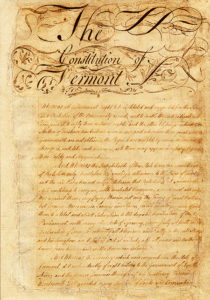Most of the questions I have involving history are because I heard someone say something that didn’t quite line up with my existing knowledge. Either that or someone posed a question I didn’t know the answer to and had to look it up. Since I spend most of my time either in a classroom or a museum, this happens quite a lot.
Today’s inquiry came from a simple statement.
John Adams wrote the Massachusetts Constitution in 1780, the oldest Constitution in the country.
So, I will start with the part that is the easiest to dispute – the date. Yes, the Massachusetts Constitution is in fact dated to 1780. However, if you live in any state besides Massachusetts, you will know instantaneously where the error lies. Massachusetts was the last of the original 13 state constitutions to be submitted.
- 1662 – Connecticut
- 1663 – Rhode Island
- 1776 – Delaware, Maryland, New Hampshire, New Jersey, North Carolina, South Carolina, Pennsylvania, Virginia
- 1777 – Georgia, New York
- 1778 – South Carolina
- 1780 – Massachusetts
If you study this timeline carefully, you’ll notice South Carolina appears twice. It’s not a mistake. They drafted a new constitution after independence is declared. (The timeline is composed from information from Constitution.org.)
Now I personally caught the mistake because of my interest in Vermont history. While the constitutions I focused on above are all state constitutions, the Republic of Vermont wrote one in 1777 that declared themselves an independent country. (This was in part due to the existing claims on the Vermont territory by both New Hampshire and New York, and to a small extent, Massachusetts.) In fact, Vermont’s 1777 Constitution has several unique features that none of the other 13 states had, nor, for that matter, the 1787 Constitution of the United States of America.
One feature was that the Vermont Constitution puts a “Declaration of the Rights of the Inhabitants of the State of Vermont” before the sections detailing the running of the government. (The United States Constitution had to add the “Bill of Rights” as Amendments after the fact.)

Another is a specific right: “That all men are born equally free and independent, and have certain natural, inherent and unalienable rights, amongst which are the enjoying and defending life and liberty; acquiring, possessing and protecting property, and pursuing and obtaining happiness and safety. Therefore, no male person, born in this country, or brought from over sea, ought to be holden by law, to serve any person, as a servant, slave or apprentice, after he arrives to the age of twenty-one years, nor female, in like manner, after she arrives to the age of eighteen years, unless they are bound by their own consent, after they arrive at such age, or bound by law, for the payment of debts, damages, fines, costs, or the like.” (Vermont Voices, p. 70)
This is the first right in the “Declaration of the Rights of the Inhabitants of the State of Vermont”. The very first thing the people of Vermont did was declare slavery illegal. This would become a selling point to Congress on accepting Vermont into the United States later in 1791 because of the need for balancing slave and free states, but it would also be a large part of the reason that Vermont participated so heavily in the American Civil War.
In addition, Vermont made voting a privilege based solely on gender. You did not have to be of the “upper sort” as you did in Massachusetts. You just had to have “a sufficient, evident common interest with, and attachment to, the community” (Vermont Voices, p. 70).
This still brings us back to the more pressing question: Why did someone think Massachusetts had the oldest Constitution when it clearly doesn’t?
Because Massachusetts’ Constitution does still have a claim to fame. It’s the first constitution that was voted into usage by the people. (Constitution.org) All the others were written by Constitution Committees and immediately enacted.
However there is another piece to this question: Is the Massachusetts constitution the oldest state constitution still in use? Well, according to most web-based sources, yes. However, this does not take into account state constitutions written before a state was admitted into the union (such as Vermont), which makes Vermont’s case tricky. The 1777 state constitution for Vermont is technically older, and written in order to hope to gain admittance as the 14th colony in the Continental Congress in the midst of the Revolutionary War. It did have some major revisions done in 1786, but it was essentially the same document, just with greater separation of powers. (Revisions, not a complete re-writing like when the US dropped the Articles of Confederation and adopted the Constitution.) The only change after that is the state constitution as we know it today – and really all that changes there is the dropping of the list of grievances that Vermont had with King George III and New York. That’s the 1793 constitution – and that’s the date that typically gets counted in these online lists of state Constitutions.
So does Vermont technically still use the 1777 constitution? Well, yes and no. That’s a very similar question to, “At what point in replacing the different parts of my desktop computer does it become a new computer?” However, it’s adoption date is (for whatever reason) still considered to be 1793.
~~~
The Constitution Society, website: http://www.constitution.org/cons/early_state_cons.htm
Ed. Graffagnino, J. K., Hand, S. B., & Sessions, G. (1999). Vermont Voices, 1609 through the 1990s: A Documentary History of the Green Mountain State. Barre, VT: Vermont Historical Society.